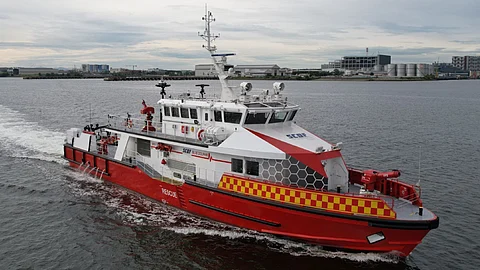VESSEL REVIEW | Blue Dolphin – Singapore Civil Defence Force welcomes new fire and rescue vessel into service
The Singapore Civil Defence Force (SCDF) commissioned a new firefighting and search and rescue (SAR) vessel into service in a ceremony on Wednesday, June 25.
The 38-metre (120-foot) aluminium-hulled Blue Dolphin was jointly developed by the SCDF, Singapore's Home Team Science and Technology Agency (HTX), the Defence Science and Technology Agency, and naval architecture firm BMT (which had also designed two earlier vessels for the SCDF). Athena Dynamics provided advisory services to ensure the vessel’s security against cyber threats.
The vessel is fitted with an integrated command post for command and control (C&C) functions during major incidents, an advanced navigational system for precise vessel handling, and a launch and recovery system (LARS) for a rigid inflatable boat (RIB) that can also be operated as a customised nearshore firefighting daughtercraft.
The LARS was designed to be capable of launching the small boat into the water in less time compared to the SCDF’s earlier RIB-carrying fireboat.
Designed as a floating command centre
Blue Dolphin features a solar-powered charging and power supply system, biofuel-compatible engines, three firefighting pumps connected to FFS monitors with a combined discharge rate of up to 4,800 cubic metres (170,000 cubic feet) per hour, a foam firefighting tank, and a sonar to aid in underwater search operations.
A self-protection water curtain gives the vessel a fully redundant and highly capable firefighting configuration that exceeds standard FiFi1 requirements.
Accommodation is available for four crewmembers and up to 10 additional personnel, and the onboard spaces have been laid out to improve crew ergonomics. The facilities include a casualty treatment room, a decontamination room, and a lounge for accommodating up to 30 rescued survivors and eight firefighters.
When the vessel is operating in the C&C role, the integrated command post collects information from multiple onboard sensors such as cameras and specialised equipment that can detect and analyse infrared signatures up to five kilometres (three miles) away. This then provides the crew with enhanced situational awareness, particularly during incidents where multiple hazards could put both responders and survivors at risk.
Fitted with advanced hazard detection sensors
The vessel is equipped to detect chemical and biological agents at lower concentrations using advanced chemical, biological and radiological (CBR) detection systems. This allows the vessel to be used for waterborne hazardous material monitoring duties wherein it would determine whether incident responders need to wear personal protective equipment while in a particular area.
Should any personnel be exposed to CBR environments, the onboard decontamination room is available for their use.
Compared to SCDF's earlier rescue vessel Red Dolphin, Blue Dolphin is around three metres (10 feet) longer, thus allowing more storage space for firefighting, SAR and medical equipment as well as a winch for facilitating transfers of injured survivors from the vessel to a hovering helicopter.
HTX said that, despite the slightly greater dimensions, the newer vessel’s improved hull design and advanced control system allow it to match Red Dolphin's top speed of 30 knots.
The higher operating speed allows the vessel to cover a distance of around 42 kilometres (26 miles) within 45 minutes, making it ideal for quick response to emergencies in both coastal and offshore waters.
The vessel is fitted with a station keeping system that ensures precise positioning during missions of extended duration, thus minimising crew fatigue.
First in a new fleet of versatile response vessels
The Bureau Veritas-classed Blue Dolphin will be operated out of the SCDF’s West Coast Marine Fire Station beginning in October 2025. Its area of operations will include the Port of Singapore.
White Dolphin, a firefighting and SAR vessel from the same series, will soon begin undergoing construction. These two newer vessels will take over the role once performed by the SCDF’s earlier dedicated firefighting craft, which were retired from service in 2021 and which were limited to a speed of 13 knots.


